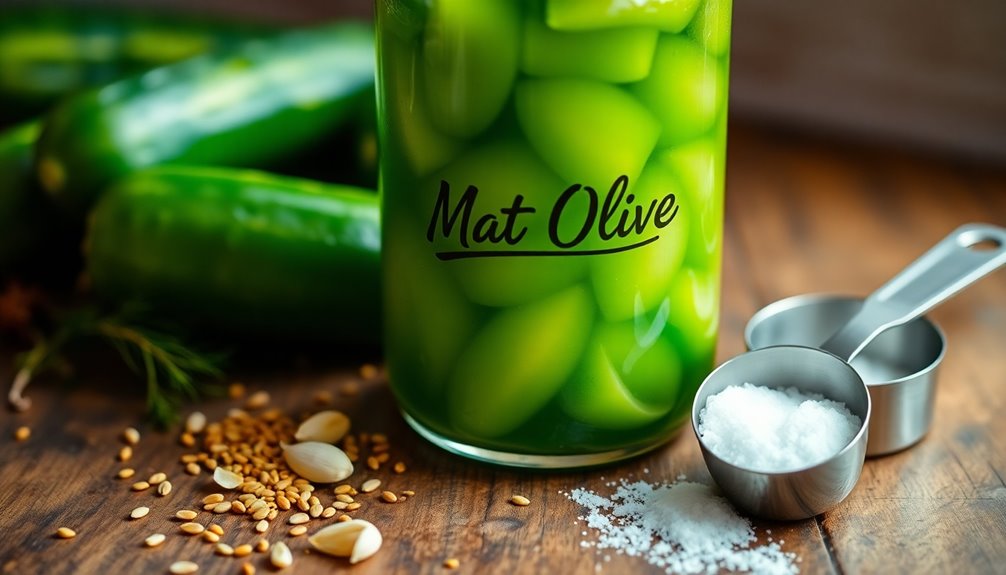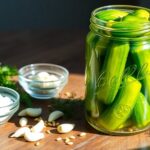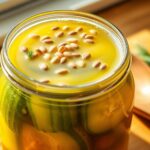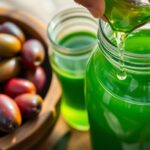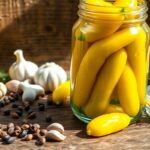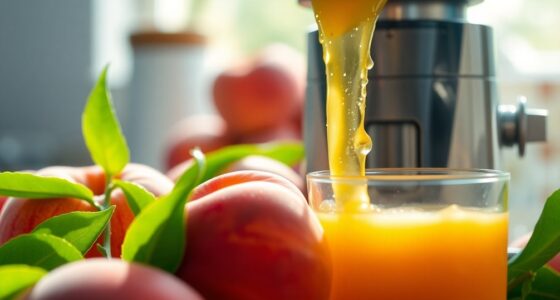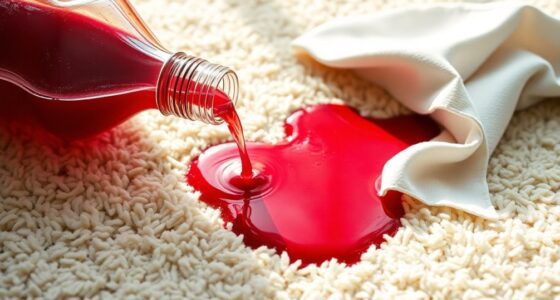To make Mt. Olive pickle juice, mix 1 cup of vinegar and 1 cup of water in a bowl. Stir in 1 tablespoon of salt and 1 tablespoon of sugar until dissolved. For extra flavor, add your favorite spices like garlic, dill, or mustard seeds. Slice your vegetables and put them in a clean jar, then pour the cooled brine over them. Seal tightly and refrigerate for at least 24 hours to enjoy robust flavors. There's so much more to explore!
Key Takeaways
- Combine 1 cup of vinegar, 1 cup of water, 1 tablespoon of salt, and 1 tablespoon of sugar to create the brine.
- Add optional spices like garlic, dill, or mustard seeds for enhanced flavor in the brine.
- Cool the brine completely before pouring it over sliced cucumbers or vegetables in a clean jar.
- Seal the jar tightly and refrigerate for at least 24 hours to allow flavors to meld.
- Use the pickle juice in various dishes or enjoy it straight for a tangy kick.
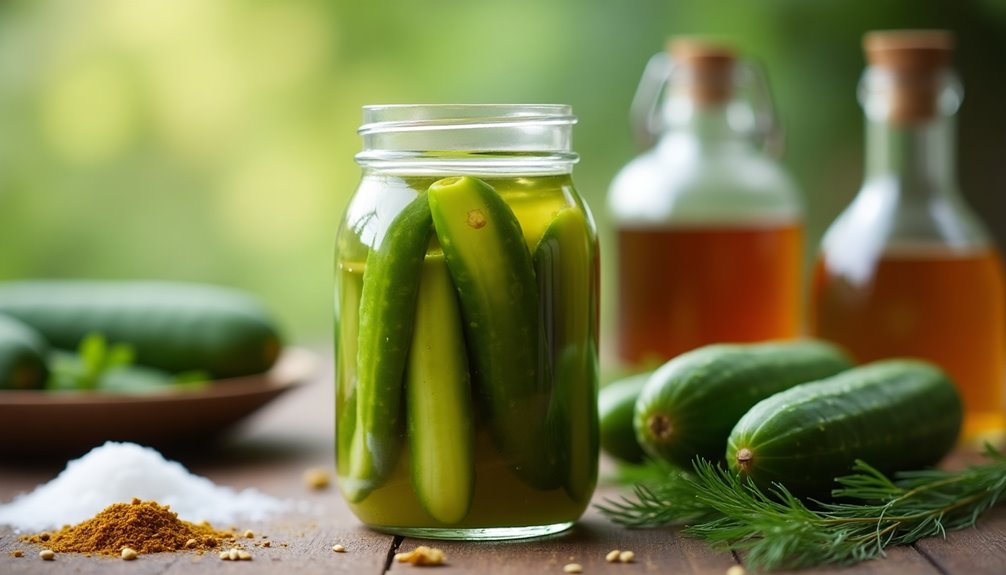
Making your own pickle juice is a simple and rewarding process that can elevate your culinary creations. If you're a fan of Mt. Olive pickle juice, you'll love how easy it's to make a homemade version right in your kitchen. With just a few ingredients, you can whip up a delicious brine that'll take your pickles, sandwiches, or even salads to the next level.
To start, gather your ingredients. You'll need 1 cup of vinegar, 1 cup of water, 1 tablespoon of salt, and 1 tablespoon of sugar. These basic components are the foundation of your brine. Once you have everything ready, mix the vinegar and water in a bowl or pot. Then, add the salt and sugar, stirring until they dissolve completely. This brine is what gives your pickle juice its signature flavor, and it's essential for that Mt. Olive taste you're after.
For those looking to add an extra kick, this is where the fun begins! Incorporate your favorite spices into the brine mixture. Garlic, dill, mustard seeds, and crushed red pepper flakes work beautifully, but feel free to experiment. The right combination of spices can personalize your pickle juice, making it uniquely yours.
After you've mixed in the spices, allow the brine to cool. This step is crucial, as pouring hot brine over vegetables can result in undesirable textures.
Now, let's prepare the cucumbers or other vegetables you want to pickle. Slice them to your desired thickness and place them in a clean jar. This jar will be the home for your homemade pickle juice. Once your brine has cooled, pour it over the freshly cut cucumbers, making sure they're fully submerged. Sealing the jar tightly is important to keep the flavors locked in.
After sealing, it's time to refrigerate your jar. Let it chill in the fridge for at least 24 hours. This waiting period allows the flavors to meld together beautifully, ensuring that each bite of your pickles is full of zest.
If you're feeling adventurous, you can adjust the type of vinegar you use. Apple cider vinegar or white vinegar can bring different notes to your pickle juice, so don't hesitate to try something new.
Once your homemade pickle juice has marinated for a day, it's ready to enjoy! You'll find that this simple recipe not only produces a tasty brine but also opens the door to countless culinary possibilities. Whether you're adding it to sandwiches, using it in salads, or enjoying it straight from the jar, your homemade Mt. Olive pickle juice will surely impress.
Frequently Asked Questions
What Is in Mt. Olive Pickle Juice?
Mt. Olive pickle juice contains vinegar, water, salt, and spices, giving it that distinctive tangy flavor you love.
You'll also find high fructose corn syrup and preservatives, ensuring it stays fresh longer. Dill and garlic might be included too, enhancing the taste you recognize.
Many fans appreciate its nutritional benefits, like relief from muscle cramps and digestive issues, thanks to the vinegar and minerals packed in the juice.
Enjoy it creatively in your cooking!
How to Make Olive Juice From Olives?
To make olive juice from olives, you’ll start by selecting ripe olives and soaking them in water for a few days to leach out the bitterness. After soaking, drain the olives and crush them to release their oils. Next, you can add some water to help extract the juice, mixing thoroughly to ensure all the flavors meld together. For those interested in enhancing their recipes, learning how to juice a lime can add a refreshing acidity that complements the rich taste of the olive juice perfectly.
After rinsing them, crush the olives using a mortar and pestle or a food processor.
Next, strain the crushed olives through a fine mesh sieve to separate the juice from the pulp.
You can add salt or herbs for extra flavor, then store the juice in the fridge.
Can I Make My Own Pickle Juice for Leg Cramps?
You might've heard that homemade pickle juice can help with leg cramps, and it's true!
You can easily whip up your own by mixing vinegar, water, and salt. This mix is rich in electrolytes, which can alleviate muscle cramps quickly.
Just combine 1 cup of vinegar, 2 cups of water, and 1 tablespoon of salt. Add spices if you like!
With this recipe, you'll have a handy remedy whenever cramps strike.
How Long Does It Take a Cucumber to Turn Into a Pickle in Pickle Juice?
When you're pickling cucumbers, the time it takes for them to turn into pickles can vary.
Typically, you'll see results in about 24 to 48 hours when using commercial pickle juice, but if you want a stronger flavor, letting them sit for up to a week is ideal.
Conclusion
Now that you know how to make Mt. Olive pickle juice, you can enjoy that tangy flavor in your favorite recipes or drinks. It's a breeze to whip up, and soon you'll be the go-to pickle juice expert among your friends. Don't hesitate to experiment with spices and flavors to make it your own. With a little creativity, you'll be in clover, savoring your homemade concoction in no time! Happy pickling!
Cindy thoroughly researches juicing trends, techniques, and recipes to provide readers with practical advice and inspiration. Her writing style is accessible, engaging, and designed to make complex concepts easy to understand. Cindy’s dedication to promoting the advantages of juicing shines through her work, empowering readers to make positive changes in their lives through the simple act of juicing.

